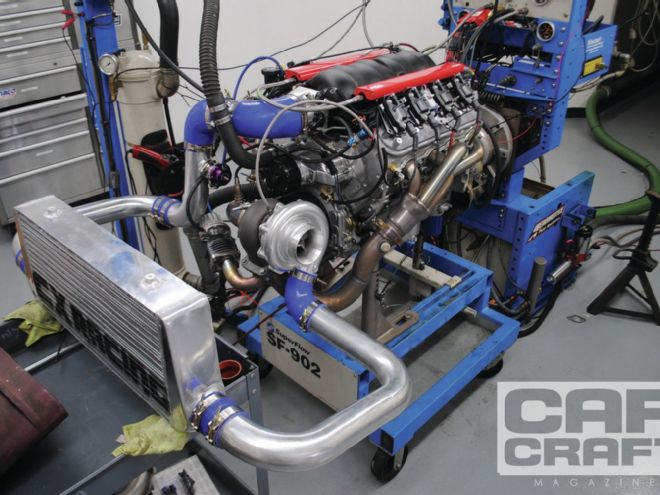
In the spectacle that is professional wrestling, signature moves come and go, but one classic has stood the test of time: the Atomic Elbow. What differentiates the Atomic version from your run-of-the-mill elbow and makes it so effective? One word: intensity. MSD's Atomic EFI is every bit as effective and might be just as devastating to the competition, but we are getting ahead of ourselves. Let's start with the fact that we were more than a little skeptical about yet another self-learning, self-tuning EFI system—especially one that promised to work equally well on normally aspirated and (of all things) power-adder applications. Seriously, can you imagine allowing a computer to tune your turbo LS motor all by itself?
Let's take a look at the promises made by the new LS-specific Atomic EFI system (other universal systems are available for conventional applications). First off, don't confuse the promotion of a wired-less system with a wireless system. The wired-less system promised and delivered a reduction in the amount of unsightly wiring. Truth be told, wiring harnesses for both factory and stand-alone EFI systems tend to border on the excessive, making it difficult to create a sanitary engine compartment. Builders have gone to great lengths to conceal all the wiring, but MSD's system has done it for you by hiding the majority of the system under trick, billet aluminum fuel rails that also incorporate the ECU circuitry. In one fell swoop, the system has eliminated the lengthy wiring harness usually associated with remote mounting the ECU(s), replacing it with a single cord run to a hand-held controller. Our one complaint is that we'd like to see an extension cable offered for in-car (or dyno) access to the controller, but the MSD Atomic EFI system gets high marks for both the visual statement and ease of installation with good instructions and a clearly labeled harness.
It looked the part, but now it was time to see if this EFI system was indeed ready to play with the big boys. Prior to installing the Atomic EFI, we tuned this LS3 we borrowed from Gandrud Chevrolet with a stand-alone system to establish a baseline. To illustrate the effectiveness of MSD's system, we decided to start off with something easy, then drop in an Atomic Elbow of our own.
First up was the stock LS3 crate motor. In truth, setting up the system was as easy as the installation. Once we had power, we simply scrolled through the easy-to-use menu of available options. For our application, all we had to do was select LS3 from the available options of LS motors, and the Atomic EFI did the rest by selecting the necessary injectors, map, and 58X trigger wheel. You can select custom options like cam profiles, but our stock engine required only that we click LS3. Fuel was supplied to the billet rail by an Aeromotive fuel pump and regulator. According to MSD, the rails are capable of supporting more than 1,000 hp.
Once programmed, the LS3 fired up at the first push of the starter button and immediately settled into an idle with an optimized air/fuel mixture. The menu on the controller allowed us to program a desired air/fuel mixture at idle, part throttle, and WOT. We selected a 12.8:1 air/fuel mixture at WOT and proceeded to make a few pulls. All we can say is wow, because the Atomic EFI system performed as promised. The system maintained the desired air/fuel mixture at all throttle angles and loads. According to MSD engineers, GM's stock timing tables were loaded into the system, meaning the settings are conservative, rather than set for maximum power. That's no problem, because not only did the controller menu allow us to add ignition timing but also functioned as a data-logging system, which can also be displayed digitally. It's hard to believe, but once we had the LS3 running with 30 degrees of total timing, to match the ignition map used with the stand-alone management system, MSD's Atomic EFI matched the power curve of the programmable EFI system.
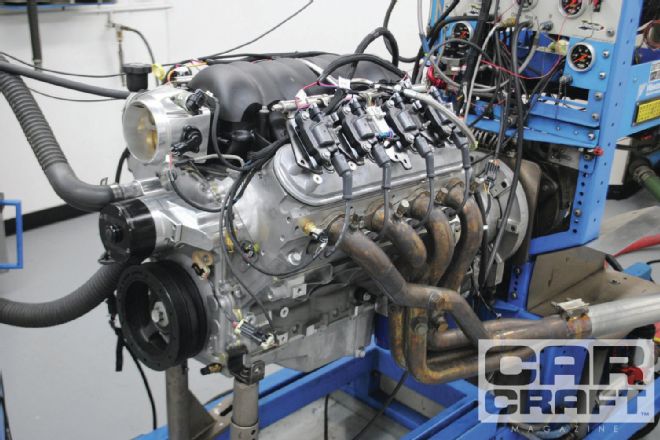 If you haven’t been around, the LS3 is a 430hp crate engine offered by Chevrolet Performance. To prove its flexiability, we’ve stroked, bored, and supercharged one in a series called Late Crate Update. That engine makes 575 hp at the wheels of our ’65 El Camino on pump gas and gets driven hard and often.
If you haven’t been around, the LS3 is a 430hp crate engine offered by Chevrolet Performance. To prove its flexiability, we’ve stroked, bored, and supercharged one in a series called Late Crate Update. That engine makes 575 hp at the wheels of our ’65 El Camino on pump gas and gets driven hard and often.
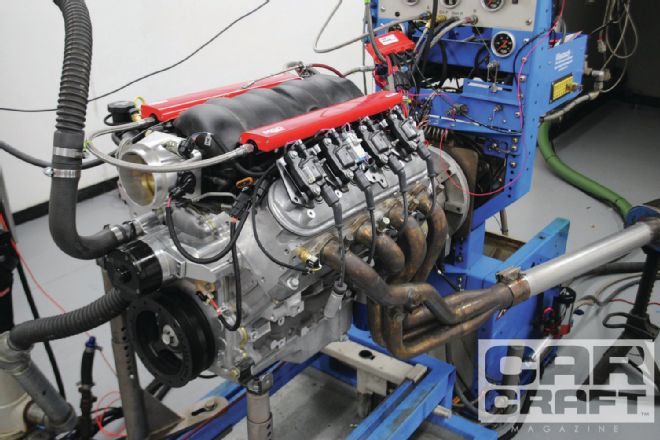 To demonstrate the effectiveness of the new Atomic EFI, we first had to establish some sort of baseline. We did this by tuning a fresh LS3 crate motor from Gandrud Chevrolet with a stand-alone management system to maximize power. We could then compare the results of the stand-alone to the self-tuning Atomic EFI.
To demonstrate the effectiveness of the new Atomic EFI, we first had to establish some sort of baseline. We did this by tuning a fresh LS3 crate motor from Gandrud Chevrolet with a stand-alone management system to maximize power. We could then compare the results of the stand-alone to the self-tuning Atomic EFI.
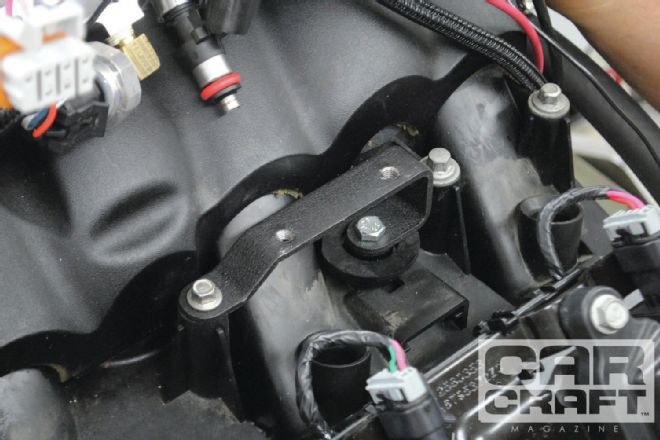 Installation of the Atomic EFI required removal of the LS3’s stock fuel rail. MSD’s billet fuel rail/electronics assembly was secured using dedicated mounting brackets provided with the kit by MSD.
Installation of the Atomic EFI required removal of the LS3’s stock fuel rail. MSD’s billet fuel rail/electronics assembly was secured using dedicated mounting brackets provided with the kit by MSD.
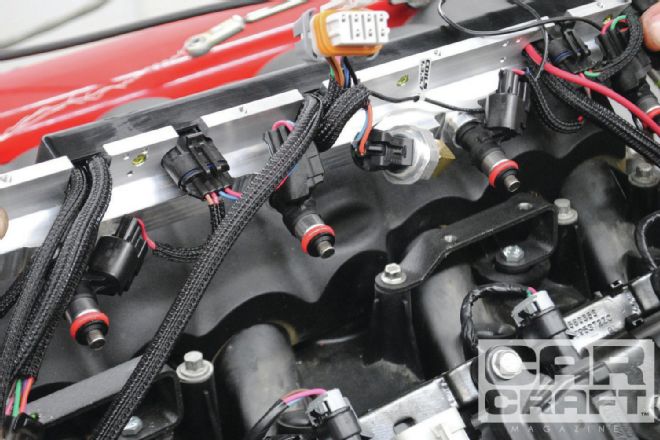 The key to the success of the Atomic EFI system is the trick fuel rails. The ECU’s electronic circuitry is integrated into the top of the rail, while nearly everything else is hidden below, including injector plugs, a fuel pressure sending unit, and wiring for the coil packs.
The key to the success of the Atomic EFI system is the trick fuel rails. The ECU’s electronic circuitry is integrated into the top of the rail, while nearly everything else is hidden below, including injector plugs, a fuel pressure sending unit, and wiring for the coil packs.
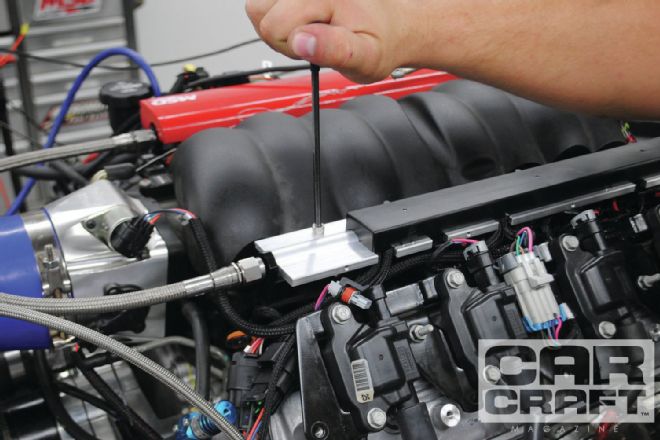 After swapping the injectors and plugging in the necessary components, we bolted the fuel rail down to the supplied mounting brackets.
After swapping the injectors and plugging in the necessary components, we bolted the fuel rail down to the supplied mounting brackets.
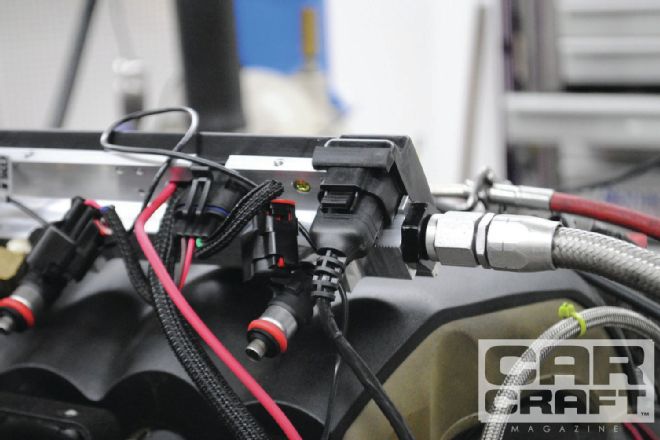 The advanced electronic controls communicate through MSD’s proprietary, patent-pending CAN-Bus technology. Simple plugs make installation a snap.
The advanced electronic controls communicate through MSD’s proprietary, patent-pending CAN-Bus technology. Simple plugs make installation a snap.
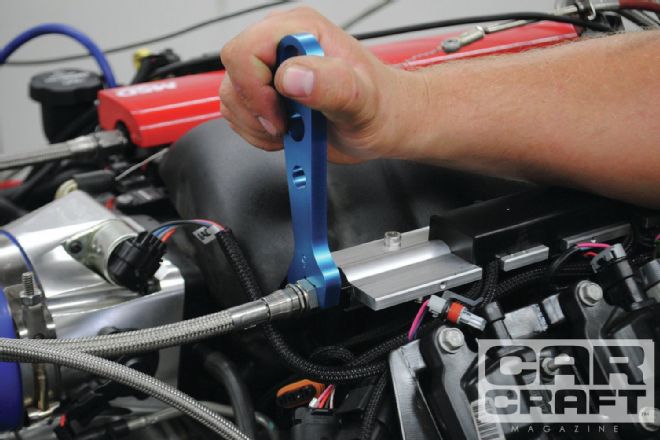 According to MSD, its billet aluminum fuel rails will support enough volume for 1,000 hp. For dyno use, we installed the necessary -8 AN fitting and lines.
According to MSD, its billet aluminum fuel rails will support enough volume for 1,000 hp. For dyno use, we installed the necessary -8 AN fitting and lines.
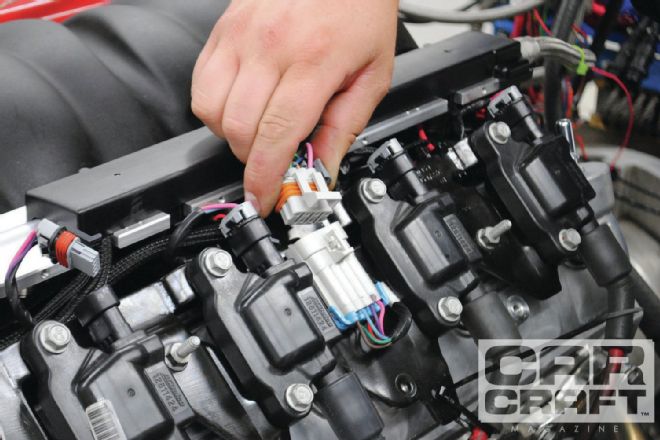 Factory-style plugs were used for the LS3 coil packs.
Factory-style plugs were used for the LS3 coil packs.
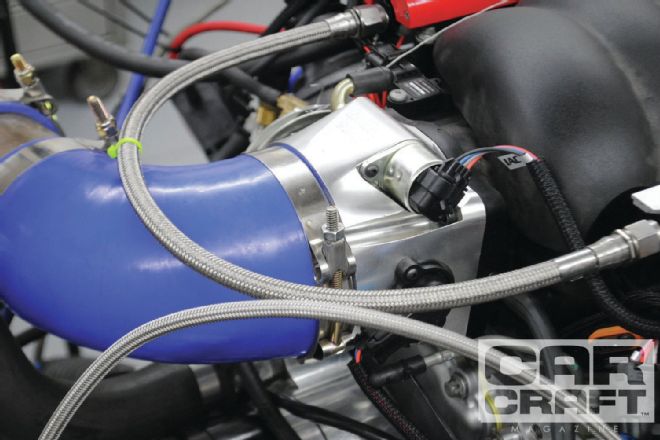 All the electrical connections, including TPS, IAC, and MAP, were clearly labeled and easy to install. The system uses speed density instead of a mass airflow (MAF) meter.
All the electrical connections, including TPS, IAC, and MAP, were clearly labeled and easy to install. The system uses speed density instead of a mass airflow (MAF) meter.
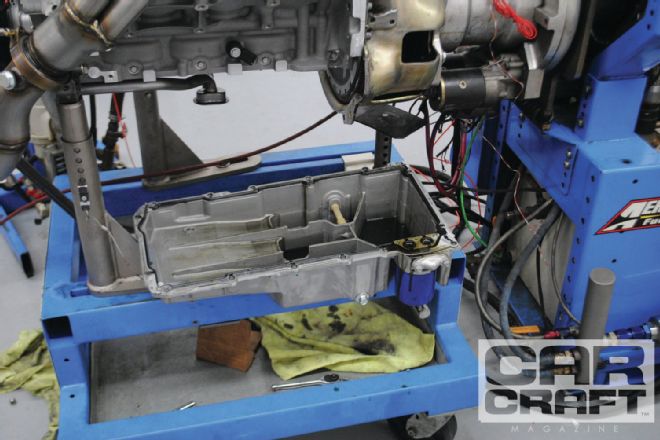 MSD supplies these trick covers for the assembly.
MSD supplies these trick covers for the assembly.
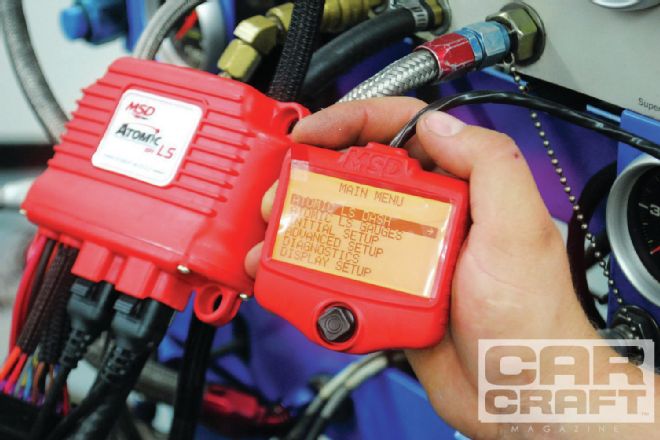 Rather than requiring a laptop, Atomic EFI features an easy-to-use handheld controller with simple menu selections. Dedicated for use on any LS variants, selecting your LS application (like our LS3) provided preset answers to all of the setup questions. It is also possible to customize your setup and command changes to both air/fuel and timing.
Rather than requiring a laptop, Atomic EFI features an easy-to-use handheld controller with simple menu selections. Dedicated for use on any LS variants, selecting your LS application (like our LS3) provided preset answers to all of the setup questions. It is also possible to customize your setup and command changes to both air/fuel and timing.
Based on both looks and performance, this Atomic EFI system seemed ideally suited for crate or other mild motor swap applications, but how would it perform on something with a little more zing? Of course, when we say zing, we really mean boost. To put the MSD to the test, we decided to install a new single turbo kit from CXRacing.com. Designed for an LS-powered F-body ('97–'02), the kit from CXRacing.comwill likely also be employed in swap applications, due to its front-mount turbo position (typical on LS applications). The stainless kit featured dedicated exhaust manifolds, a Y-pipe with T4 turbo, and integrated wastegate flanges. The kit also included a wastegate, a blow-off valve, and a 76mm turbo capable of supporting 800 hp. Keeping things cool was a massive, front-mounted, air-to-air intercooler, complete with all the necessary tubing, couplers, and clamps. The aluminum tubing even features beaded ends to improve sealing. Having used the 76mm turbos time and time again on various projects, it is amazing that all this hardware (minus the intercooler) sells for around $1,000.
We wondered if the Atomic EFI system would be up to the task of properly tuning a turbo LS3, so with fingers crossed, we commanded an air/fuel ratio of 11.8:1, and changed the stock MAP sensor for one of the 2-bar sensors listed in MSD's menu. As an aside, we would recommend MSD list the map sensors under 1-bar, 2-bar, or 3-bar settings, rather than part numbers, but we managed to cross-reference the necessary sensor for our test. You can also purchase a MAP sensor directly from MSD. Once again, the LS3 started on the first try and was humming away with the new turbo kit. Loading the motor with the dyno revealed the air/fuel mixture was spot-on and that MSD's engineers had again erred on the conservative side in terms of ignition timing. Full-throttle runs revealed an air/fuel mixture right at the requested 11.8:1, and we actually had to add timing (the desired method) to improve the power output with the turbo.
Aeromotive's fuel pump was capable of supporting considerably more power, but the limiting factor turned out to be our use of factory 42-pound injectors. The Atomic EFI system will accept larger injectors, but we didn't have any available for this test. Despite the injector snafu, we did manage to coax as much as 660 hp and more than 700 lb-ft of torque before running out of injector flow. These represent gains of nearly 180 hp and more than 225 lb-ft of torque at just 7 psi of boost. Turbo response was excellent, the intercooler kept the charge temperatures nice and cool, and the wastegate never missed a beat. The one area we would like to see improved on the turbo kit is the flow rate of the blow-off valve—maybe running two of the smaller units. With more fuel, the single-turbo system from CXRacing.comshould be capable of getting nearly 800 hp, or you can step up to the twin-turbo system capable of, you guessed it, 1,600 hp. The goal of this test wasn't to maximize the power output of our stock LS3 but rather to illustrate that the Atomic EFI was capable of self tuning both an NA and turbo application. If the results of this test are any indication, MSD just dropped an Atomic Elbow.
Turbo Power Graph
This graph illustrates that both the single turbo system from CXRacing.com, and MSD's Atomic EFI system performed as advertised on the LS3 crate motor. Use of stock injectors ultimately limited the power gains, the single-turbo system was capable of supporting 800 hp, and the Atomic EFI System provided a rock-steady (commanded) air/fuel m ixture of 11.8:1. We liked the fact that the engineers were purposely conservative on the timing values, requiring us to add timing to dial in the power. This is exactly the procedure you should take when tuning with a conventional stand-alone EFI system. Using the Atomic EFI, the CXRacing turbo kit increased the power output of the stock LS3 from 482 hp and 483 lb-ft to 658 hp and 709 lb-ft of torque at just less than 7 psi.
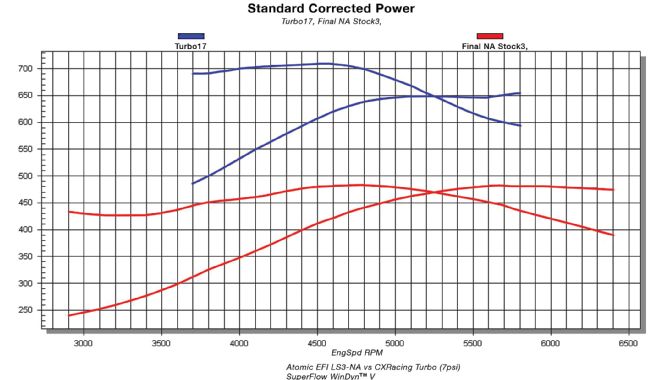
Parts List
Description Source PN Price Atomic LS EFI MSD 2950 $2,495 Twin- turbo kit* CX Racing TRB-KIT-HD-LS1-T76-P96 $1,069 LS3 crate engine Summit Racing 19258770 $6,999.99*Intercooler sold separately
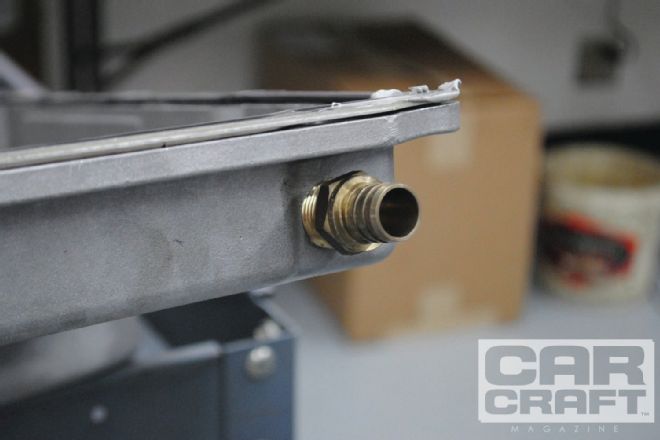 Next, we drilled and tapped the front of the oil pan for a suitable barb fitting to serve as the oil drain from the turbo.
Next, we drilled and tapped the front of the oil pan for a suitable barb fitting to serve as the oil drain from the turbo.
 The Atomic EFI system performed flawlessly on the stock crate motor, but could it handle the needs of a wilder turbo combination? The first step was to install the new F-body single turbo kit from CXRacing.com. Installation of the kit required dropping the stock oil pan.
The Atomic EFI system performed flawlessly on the stock crate motor, but could it handle the needs of a wilder turbo combination? The first step was to install the new F-body single turbo kit from CXRacing.com. Installation of the kit required dropping the stock oil pan.
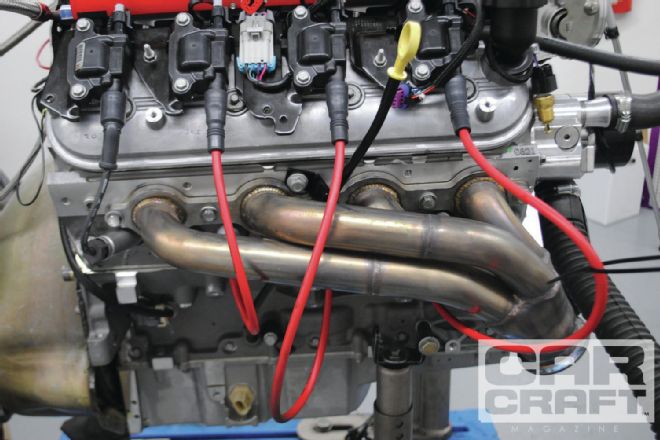 The turbo kit features dedicated tubular exhaust manifolds. The proximity of the manifolds required use of longer-than-stock plugs wires. Ours came as part of a universal LS kit from MSD.
The turbo kit features dedicated tubular exhaust manifolds. The proximity of the manifolds required use of longer-than-stock plugs wires. Ours came as part of a universal LS kit from MSD.
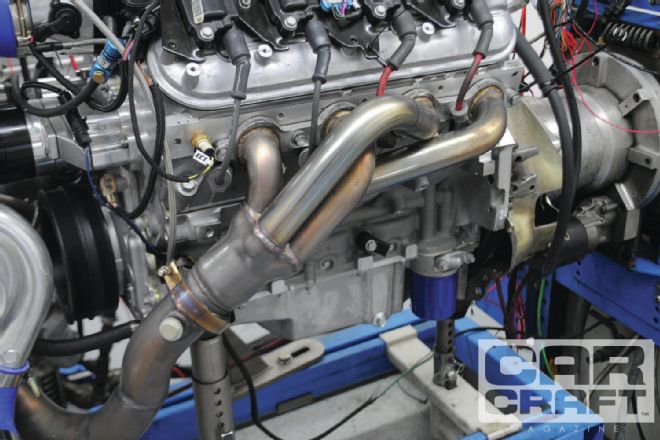 Exhaust from the manifolds was channeled to the turbo via a dedicated Y-pipe.
Exhaust from the manifolds was channeled to the turbo via a dedicated Y-pipe.
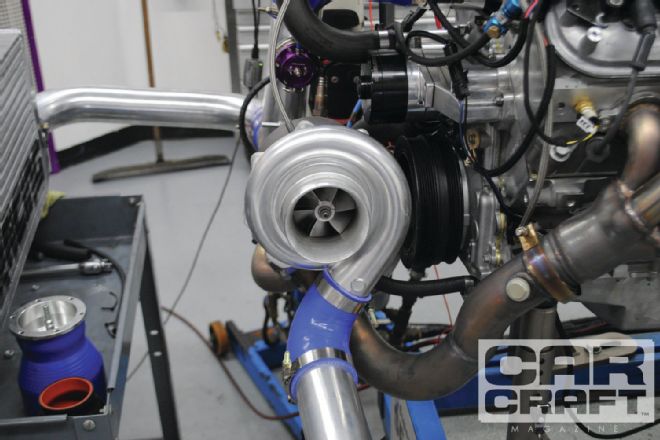 Given the power potential of a turbo LS3, we selected the largest turbo offered by CXRacing.com. The 76mm turbo features a 4-inch compressor inlet, a 2.5-inch outlet, and a P-Trim exhaust with a 0.96 A/R. The turbo has been tested to supply nearly 800 hp.
Given the power potential of a turbo LS3, we selected the largest turbo offered by CXRacing.com. The 76mm turbo features a 4-inch compressor inlet, a 2.5-inch outlet, and a P-Trim exhaust with a 0.96 A/R. The turbo has been tested to supply nearly 800 hp.
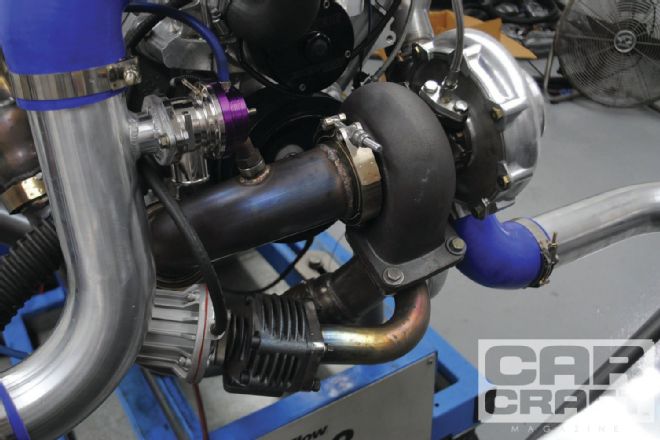 The turbo kit also includes a wastegate, a blow-off valve, and a 3-inch downpipe. Note the provision for an oxygen sensor in the downpipe.
The turbo kit also includes a wastegate, a blow-off valve, and a 3-inch downpipe. Note the provision for an oxygen sensor in the downpipe.
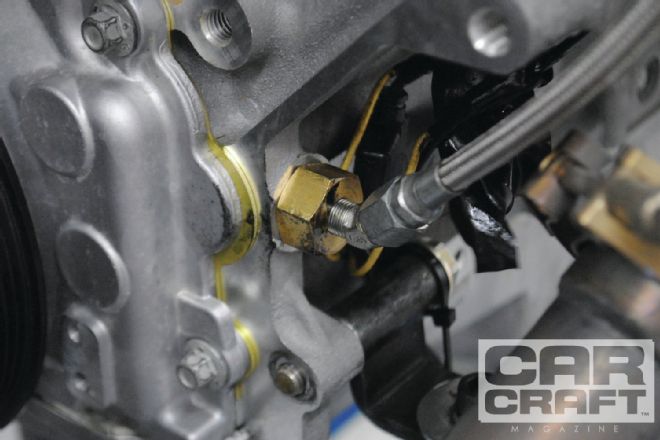 Turbos require a dedicated oil supply. In this application, oil came from the passage at the front of the block on the driver side.
Turbos require a dedicated oil supply. In this application, oil came from the passage at the front of the block on the driver side.
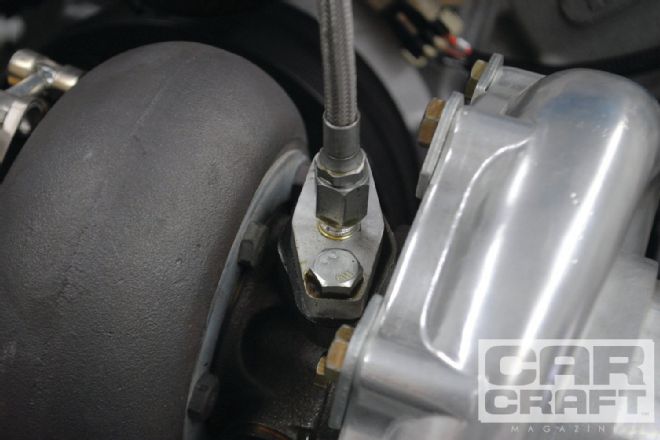 The oil feed fitting supplied by CXRacing incorporates an oil restrictor, because excessive oil supply to the turbo can leak past the seals, causing smoke in the exhaust and oil consumption.
The oil feed fitting supplied by CXRacing incorporates an oil restrictor, because excessive oil supply to the turbo can leak past the seals, causing smoke in the exhaust and oil consumption.
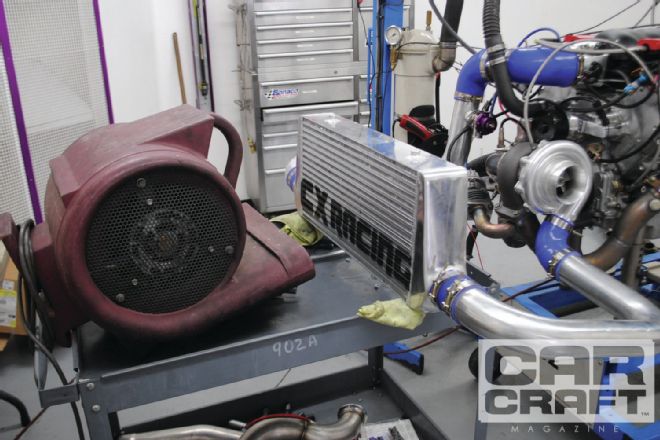 Intercoolers should be considered mandatory on any forced induction application, and this kit comes with an, efficient, front-mount air-to-air intercooler. Air supply during testing came from a large cooling fan.
Intercoolers should be considered mandatory on any forced induction application, and this kit comes with an, efficient, front-mount air-to-air intercooler. Air supply during testing came from a large cooling fan.
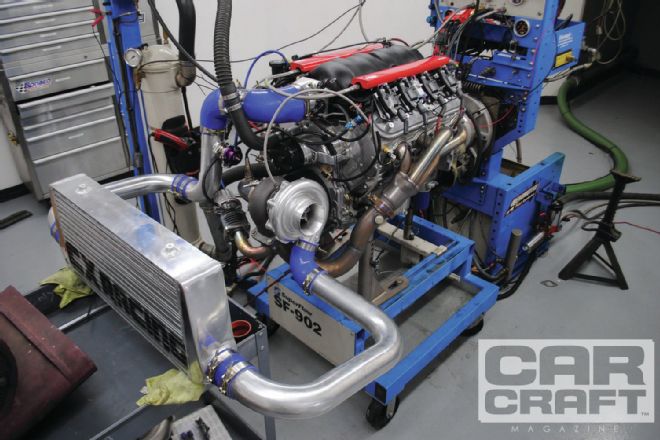 The stock injectors eventually limited power output of our turbo LS3. MSD’s Atomic EFI will easily accept larger injectors, but we chose to crank up the static pressure and boost reference the Aeromotive fuel-pressure regulator. Despite fuel flow limitations, the Atomic EFI system performed flawlessly on our turbo LS motor, allowing us to add almost 180 hp and more than 225 lb-ft of torque with the turbo kit before running out of fuel.
The stock injectors eventually limited power output of our turbo LS3. MSD’s Atomic EFI will easily accept larger injectors, but we chose to crank up the static pressure and boost reference the Aeromotive fuel-pressure regulator. Despite fuel flow limitations, the Atomic EFI system performed flawlessly on our turbo LS motor, allowing us to add almost 180 hp and more than 225 lb-ft of torque with the turbo kit before running out of fuel.